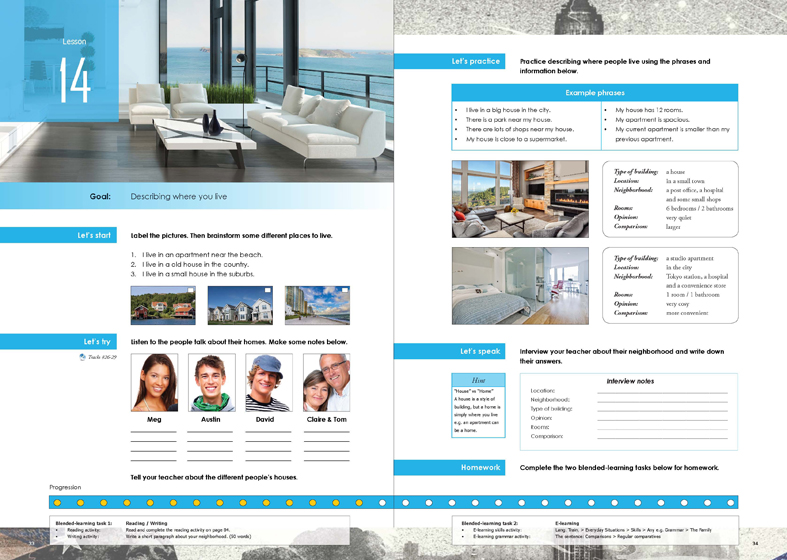
Manuals > General English > Rosetta Stone Advantage > Beginner - Book 1 > Lesson 14
< Previous Lesson | Next Lesson >

By the end of the lesson, the student should be able to describe where they live.
Communication strategies:
The student should be able to able to describe where they live using the 5 steps below:
1) State what kind of building they live in
2) State where they live
3) Give their opinion of their building using a simple adjective
4) Share some information about their place and compare it to others.
5) State what conveniences are close to their building
e.g. I live in a studio apartment near the station. My apartment is very nice. It has three rooms. My friend lives in the same building, but my apartment is a little bigger. There are lots of convenience stores near my place. There is also a big supermarket just down the road. I like living in my apartment.
Words and rules:
The student should be able to use prepositions of place. e.g. I live in Tokyo.
The student should be able to name some different places where people live e.g. in a house / in the country side
The student should be able to use comparatives e.g. My house is nice than my friend's house.
Appropriateness:
Register: When talking to a friend we usually use a casual register.
Social rules: If we don't know someone very well, we usually don't ask them too much about where they live.
Cultural references: "in the sticks" or "in the boonies" is slang for "in the country side".
Track #26 - Meg
I live in a small house in the suburbs. There is a park near my house and there are lots of trees in my neighborhood.
Track #27 - Austin
I live in an apartment downtown. There are a lot of shops and restaurants
in my neighborhood.
Track #28 - David
I live in a big house in the countryside. My house has 12 rooms. The view from my house is amazing.
Track #29 - Claire and Tom
We live in a condo near the beach. It’s small, but it’s the perfect size for us.
Because the lesson touches on the topic of where people live, you are welcome to introduce some of the following vocabulary if you like.
1) the city (n)
2) the country (n)
3) the suburbs (n)
4) a mansion (n)
5) a condo (n)
6) a flat (n)
7) a unit (n)
8) a tent (n)
9) a dormitory (n)
10) a townhouse (n)
Option 1:
Difficulty ★
Type: Vocabulary introduction
Purpose: Stating the names of the different rooms
Method: Teach the student about what different rooms are called. You can do this by bringing
up pictures if you like. You can also brainstorm the different actions you do in each room if you like.
e.g. I cook in the kitchen.
Option 2:
Difficulty ★★
Type: Grammar practice
Purpose: Teaching the student how to use comparatives
Method: Before the lesson, do a Google search, and bring up some pictures of things that are
easy to compare. Use this pictures in the lesson to practice using comparatives. Because this lesson focuses on houses, you might want to bring up some pictures of different houses.
You can then practice exchanging opinions.
e.g. This house is older than this house, but I think this one is more expensive.
Option 3:
Difficulty ★★★
Type: Presentation
Purpose: Comparison practice / Fluency practice
Method: Have the student imagine that they are now living in their dream house. Have them tell
you all about their dream house using their imagination, then compare it to one of their friend's houses.
e.g. I love my new house. It’s great. It has 100 rooms. It’s much bigger than Tom’s house. His house only has 2 rooms.
(Note: If the student is imagining they are living in the house now, they don’t need to
use “would”, this grammar might be too hard for this level)
Extra questions you might like to ask in the lesson
- Where do you live?
- What’s your place like?
- What’s the neighborhood like?
- How big is your place?
- What is your favorite room?
- Whose place is bigger?
Let’s start
Label the pictures.
I live in a old house in the country.
I live in a small house in the suburbs.
I live in an apartment near the beach
Let’s try
Listen to the people talk about their homes. Make some notes below.
Track #26
Meg lives in a small house in the suburbs. There is a park near her house and there are lots of trees in her neighborhood.
Track #27
Austin lives in an apartment downtown. There are a lot of shops and restaurants in his neighborhood.
Track #28
David lives in a big house in the countryside. His house has 12 rooms. The view from his house is amazing.
Track #29
Claire and Tom live in a condo near the beach. It’s small, but it’s the perfect size for them
Let’s practice
Practice describing where people live using the phrases and information below.
Type: a house
Place: in a small town
Neighborhood: a post office, a hospital
and some small shops
Rooms: 6 bedrooms / 2 bathrooms
Style: quiet
Comparison: larger
I live in a house in a small town. There is a post office and a hospital near my house. There are also lots of shops near my house. My house has 6 rooms and two bathrooms. My house is very quiet. My current house is larger than my old house.
Let’s speak
Interview your teacher about their neighborhood and write down their answers.
Location: Where do you live?
Neighborhood: What’s in your neighborhood?
Type of building: Do you live in a house or an apartment?
Opinion: What’s your house like?
Rooms: How many rooms do you have?
Comparison: Is this house bigger than your last house?